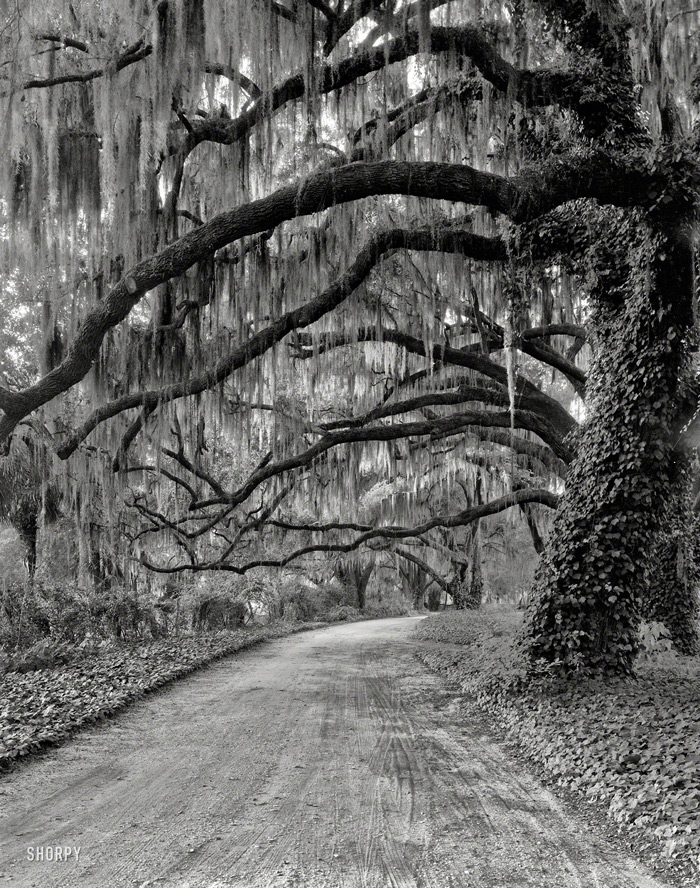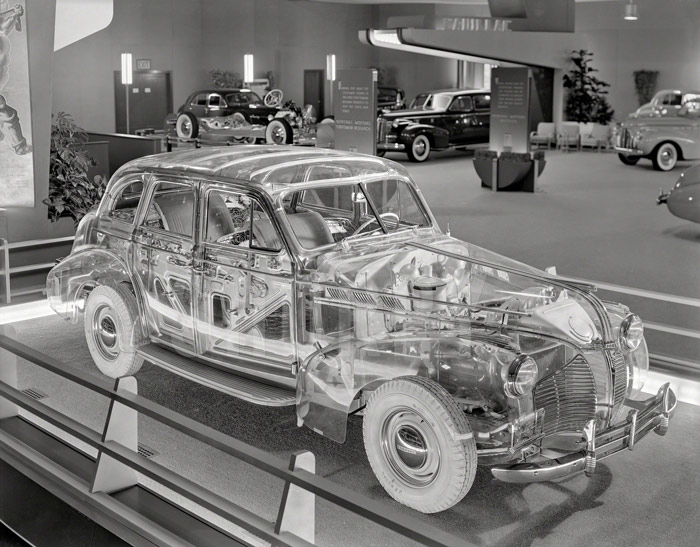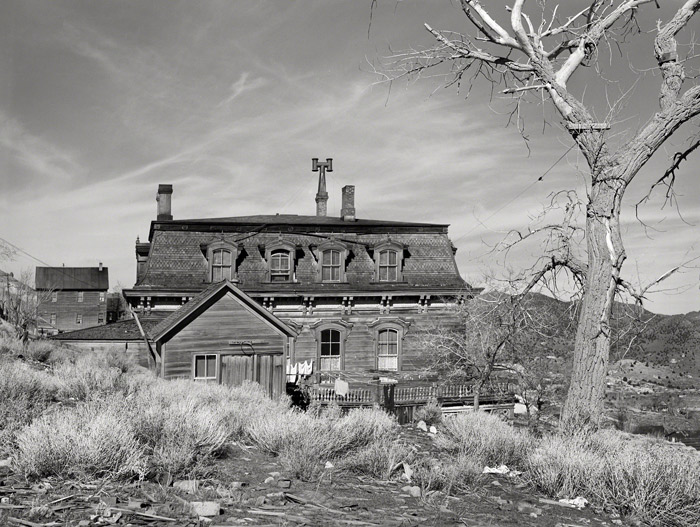Hole in the Clouds
Nov 23, 2011
 In 1940, Nick chose to black out one word on the sign in front of his Greek restaurant in Paris, Kentucky, the word that came between "real" and "spaghetti." Mussolini's Fascist regime had just invaded Greece, and the now-missing word, of course, must have been "Italian."
In 1940, Nick chose to black out one word on the sign in front of his Greek restaurant in Paris, Kentucky, the word that came between "real" and "spaghetti." Mussolini's Fascist regime had just invaded Greece, and the now-missing word, of course, must have been "Italian."
streetscape
politics
World War II
signage
Paris, Kentucky
1940
(Image credit: John Vachon, Farm Security Administration)
Dec 3, 2011
 Maybe the gingerbread man was in that Folger's coffee can?
Maybe the gingerbread man was in that Folger's coffee can?
Government photographer John Vachon immortalized this scene while he was doing his Farm Security Administration work in Minnesota and the Dakotas in the spring of 1940. But he didn't record any explanations.
animal
car
Minnesota
1940
fox
Moorhead
(Image credit: John Vacon, Farm Security Administration, via Shorpy)
Feb 19, 2012
 Boys playing marbles in May 1940, in Woodbine, Iowa. I don't know when exactly American children gave up marble-playing, but by the late 1950s, when I was a serious student of childhood fun in America, nobody played with marbles any more.
Boys playing marbles in May 1940, in Woodbine, Iowa. I don't know when exactly American children gave up marble-playing, but by the late 1950s, when I was a serious student of childhood fun in America, nobody played with marbles any more.
They still rode bikes, however. And there were other games in which you could lose all your stuff, such as flipping baseball cards.
In 1940, Woodbine, Iowa, was a relatively prosperous place, center of Iowa's apple-growing industry, which was the second-largest in the nation. But a freak blizzard in the early fall of that year, about six months after this picture was taken, froze the trees before summer's new growth had hardened off; all but the very oldest trees turned black and died, and Woodbine never really recovered economically.
children
streetscape
boys
bike
1940
marbles
games
Woodbine
Iowa
(Image credit: John Vachon, Farm Security Administration, via Shorpy)
Oct 24, 2013
 In 1940, when photographer Frances Benjamin Johnston visited Wormsloe Plantation near Savannah, Georgia, the approach looked much as it had in antebellum times. Twentieth-century horseless carriages left different tracks in the dirt of the mile-and-a-half-long driveway, but intervening decades had done nothing to change the overall effect of oak and moss and ivy.
In 1940, when photographer Frances Benjamin Johnston visited Wormsloe Plantation near Savannah, Georgia, the approach looked much as it had in antebellum times. Twentieth-century horseless carriages left different tracks in the dirt of the mile-and-a-half-long driveway, but intervening decades had done nothing to change the overall effect of oak and moss and ivy.
The original plantation house, however, built in the mid-eighteenth century out of tabby–cement made primarily of crushed oyster shells–crumbled away long ago. A nineteenth-century replacement house is still controlled by descendants of the family that built the place, though most of the acreage was deeded over to the state during the Depression.
In the early years of the twentieth century, the family name was changed from Jones to DeRenne, and the spelling of the plantation was changed from Wormslow to Wormsloe. They must have had their reasons.
tree
driveway
road
Georgia
1940
plantation
Savannah
oak
spanish moss
(Image credit: Frances Benjamin Johnston, via Shorpy)
Apr 12, 2015
 This plexiglass Pontiac, from the very earliest days of plastics, was a big hit at the 1939 New York World's Fair; it is shown here doing its star turn in the General Motors pavilion at the 1940 International Columbian Exhibition in San Francisco.
This plexiglass Pontiac, from the very earliest days of plastics, was a big hit at the 1939 New York World's Fair; it is shown here doing its star turn in the General Motors pavilion at the 1940 International Columbian Exhibition in San Francisco.
In 2011, it was auctioned by Sotheby's for $308,000. It was still a working automobile at that time, though the plastic chassis (body by Fisher) obviously would not hold up under heavy use. The odometer reading was 86 miles.
car
1940
General Motors
antique car
plexiglass
transparent
Pontiac
(Image credit: Wyland Stanley Collection via Shorpy)
Jan 30, 2018
 There's laundry in the yard here at the old Savage house, but only a few items; most of the clotheslines hold only empty clothespins. So we'll call it a Tuesday instead of a Monday.
There's laundry in the yard here at the old Savage house, but only a few items; most of the clotheslines hold only empty clothespins. So we'll call it a Tuesday instead of a Monday.
The house was built in 1861, only two years after discovery of the Comstock Lode, which set off a silver rush to Nevada, much like the gold rush to California a decade earlier. Administrative offices of the Savage Mining Company occupied the first floor; a succession of mine superintendents and their families lived above the offices, on the second and third floors.
The office and house were on D Street in the very young town of Virginia City, Nevada. The first Savage mine shaft was on B Street. Although the town was barely a year old in 1861, it already contained 42 saloons, 42 stores, 9 restaurants, 6 hotels, and a couple of thousand miners, many of whom had already spent years prospecting in California.
All the trees for miles around were already cut down, mostly for use as mine timbers.
The Savage mansion had 21 rooms and was probably the largest structure in town. The company provided a housekeeper for the superintendents in residence, and for many years the housekeepr was a Mrs. Monoghan, whose husband had died in one of the Savage mines.
In 1918, when Savage shut down its operations in Virginia City, after years in which mines thereabouts produced less and less good ore, the house, furnishings, and D Street property were deeded to Mrs. Monaghan. By the time this photographer happened by in 1940, the silver bonanza that built the house and the city had been over for a long, long time.
Recently, Virginia City is gentrifying, attracting tourists. The Savage Mansion is now completely restored and painted yellow. The building is still privately owned and serves as office space.
vintage
house
mining
work
1940
decay
Leonard Coates Savage
Comstock Lode
Virginia City, Nevada
(Image credit: Arthur Rothstein via Shorpy)
 In 1940, Nick chose to black out one word on the sign in front of his Greek restaurant in Paris, Kentucky, the word that came between "real" and "spaghetti." Mussolini's Fascist regime had just invaded Greece, and the now-missing word, of course, must have been "Italian."
In 1940, Nick chose to black out one word on the sign in front of his Greek restaurant in Paris, Kentucky, the word that came between "real" and "spaghetti." Mussolini's Fascist regime had just invaded Greece, and the now-missing word, of course, must have been "Italian."



